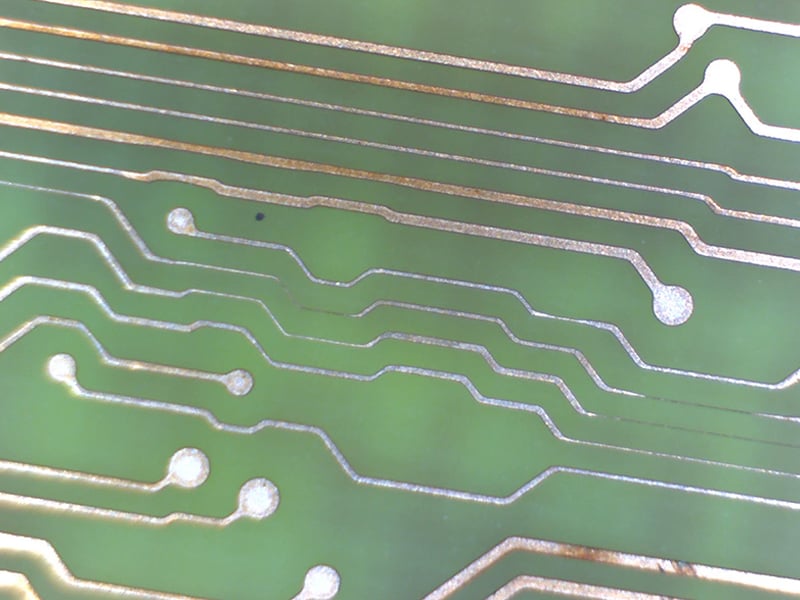Etch compensation is a process used in the design of printed circuit boards (PCBs) to adjust the trace widths to compensate for any changes that occur during the PCB manufacturing process. When PCBs are manufactured, the etching process used to create the copper traces on the board can cause some amount of variation in the width of the traces. This variation can be caused by factors such as the thickness of the copper, the quality of the etching process, and the chemical composition of the etchant.
To account for these variations, PCB designers may intentionally adjust the width of the traces in the design to compensate for the expected variation in the manufacturing process. This can help ensure that the final circuit board meets the design specifications and performs as intended. The amount of etch compensation required can vary depending on the specific manufacturing process used and the requirements of the PCB design.

Example of a tight trace. This is what happens when there is no room to space out features and we opt NOT to etch comp them fully. Those thin dark traces are too small to be reliable and did not pass quality control.
Benefits To Using Etch Compensation
There are several benefits to using etch compensation in the design of printed circuit boards. These include:
- Improved Accuracy: By compensating for the expected variations in the manufacturing process, PCB designers can ensure that the final PCB meets the desired specifications with greater accuracy.
- Better Performance: Etch compensation can help to ensure that the PCB performs as intended, by ensuring that the correct trace widths are used to maintain signal integrity and prevent issues such as crosstalk or signal distortion.
- Cost Savings: By reducing the need for post-production adjustments, etch compensation can help to reduce the overall cost of manufacturing the PCB.
- Faster Turnaround Time: With more accurate and reliable PCB designs, manufacturers may be able to produce PCBs more quickly, reducing lead times and allowing products to be brought to market more rapidly.
- Greater Design Flexibility: Etch compensation can enable designers to use a wider range of manufacturing processes, without sacrificing accuracy or performance. This can allow for greater design flexibility and innovation.

Illustration of what happens when we etch comp customer data BUT don’t have any room to space features apart.
Etch Compensation Process
When we etch unwanted copper off a PCB layer, we still end up losing some of the features we are trying to protect underneath the dry film artwork. We stay within the client’s desired tolerance by doing etch compensation. This is where CAM increases the surface area of the photoresist from the original artwork in anticipation that the desired copper features are going to shrink from contact with the etching solution.
One thing that is maybe not always considered in customer design is the fact that this process can create feature overlap when trace/space is very tight. Overlapping features simply will not etch in the desired way. We see this more often in layers with higher copper weight because it will take more work to etch a 2oz layer than a 0.5oz layer. More work means that more of the desired features are going to etch away as well. In other words, higher copper weights will need more etch compensation. This can become convoluted when a PCB contains multiple layers with different copper weights (especially 2oz or higher).
We have done a lot of research using empirical data to determine a very precise ruleset that can be applied reliably for all jobs, so hitting the desired tolerance is easy peasy. However, additional risk is integrated whenever CAM must fix spacing issues that result from the etch compensation process. After all, real estate on a printed circuit board tends to be ‘already occupied’.
While certainly not comprehensive, the following video illustrates one of the most common problems that result from this process: spacing out features so that they will etch properly without running into drills or causing netlist issues.
Watch Recording Below:
Summary
The process of etching unwanted copper off a layer in PCB design can result in the loss of some desired features, especially in layers with higher copper weights. Etch compensation is used to stay within the client's desired tolerance, but it can create feature overlap when trace/space is very tight. While empirical data has helped develop a precise ruleset for this process, additional risk is introduced when CAM must fix spacing issues. Real estate on a circuit board is typically already occupied, making it crucial to carefully navigate this process.
Key Takeaways
- Etch Compensation Offsets Copper Loss During Fabrication: Etch compensation adjusts trace widths in PCB data to account for copper loss during the etching process, ensuring final dimensions match the intended design.
- Tight Trace/Space Designs Can Introduce Overlap Risks: When features are tightly packed, applying etch compensation can unintentionally cause overlaps or spacing violations, especially problematic in high-density designs or layers with heavy copper.
- Higher Copper Weights Require Greater Compensation: Thicker copper (like 2oz) etches more aggressively, so it requires more compensation. This makes layout planning even more critical when using mixed copper weights in multilayer designs.
- Accurate Compensation Improves Quality and Reduces Rework: By proactively adjusting for etch loss, manufacturers can improve accuracy, maintain signal integrity, reduce scrap, and accelerate production, all of which contribute to lower overall costs.
- Collaboration with CAM Prevents Unintended Issues: Designers should work closely with PCB manufacturers to understand etch compensation limits and avoid trace spacing issues that CAM engineers may have to resolve post-design, often with limited space to work.
















